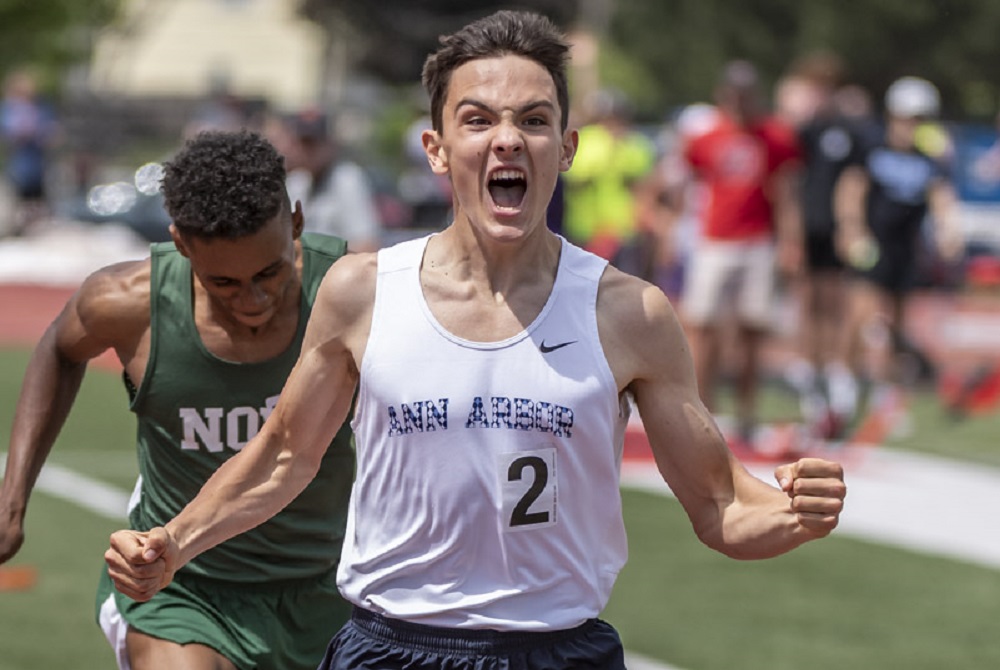
Memorable Wins and Multi-Champs Highlight LPD1 Track's Return
By
Steve Vedder
Special for MHSAA.com
June 5, 2021
KENTWOOD – The particulars didn't necessarily matter to Rockford coach Andrew Martin. The only thing which truly mattered was the stunning finish to Saturday's Lower Peninsula Division 1 boys track & field championships at East Kentwood.
Seemingly out of the running for the team title, the Rams' 1,600 relay – a foursome not even running in the event's fast heat – managed a third place in the final event to earn Rockford a tie with Fenton for first place in a wild meet.
Both teams finished with 34 points. Instead of finishing as low as third place in a meet where the top eight were separated by just 12 points, Rockford earned its first Finals crown in 12 years under Martin.
"It doesn't matter how we got there," Martin said of tying for the title. "We were seeded 10th, but these kids are all about doing your own thing."
The Rams relay was comprised of three seniors in Daniel Leja, Gage Martin and Jacob Peck and junior Jacob Bissell. While they finished with a time of 3:23.84, Fenton was slowed by not having a team qualify for the final relay. It was a turn of events which left Fenton coach Anthony McMillan pacing nervously as the final race played out.
"To still do what we did was great," he said. "These kids left a legacy, a path. To bring a state title home is a very special moment. To be one of the (two) teams means a lot to us."
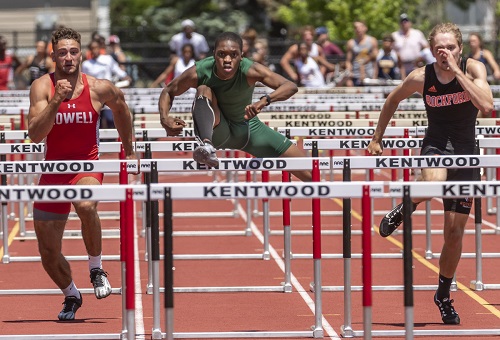 Rockford and Fenton were far from the only teams with a breath of life until the final event. Zeeland West finished third with 30 points, Ann Arbor Skyline had 28, Pinckney and Novi 25 and Dexter and Macomb Dakota 24.
Rockford and Fenton were far from the only teams with a breath of life until the final event. Zeeland West finished third with 30 points, Ann Arbor Skyline had 28, Pinckney and Novi 25 and Dexter and Macomb Dakota 24.
While the team title was captivating to the very end, Skyline's Hobbs Kessler virtually stole the individual part of the Finals. Kessler, who became the first Michigan high schooler to qualify for the Olympic trials in 80 years, won the 1,600 (4:16.68) and the 800 (1:54.13). While those finishes weren't necessarily surprises, Kessler's ability to live up to high expectations – including amazing kicks in both events – was even more impressive.
"It's the way I like to win," he said of running his last lap of the 1,600 in 55.1 seconds while also coming from behind to win the 800. "I want to give myself the best shot to win. The wind hit, and I snuck in.
"I know if I work out well and run my best, good things will happen. I know who I have to listen to, and the others aren't as important. I have a good support system, so I can just go out and win."
Kessler qualified for the Olympic trials last Saturday. He said he'll think more about the future now that the high school season is completed. But he wouldn't rule out competing in this summer's Japan Olympics.
"There's no reason to think I can't," he said.
Among the other double winners at East Kentwood were Tamaal Myers II of Detroit Cass Tech, who claimed the 110 hurdles (14.26) and 300 hurdles (37.87), and Udodi Onwuzurike of Bloomfield Hills Brother Rice, who won the 100 (10.55) and 200 (21.23).
Myers said an extremely strong headwind didn't do runners any favors. But he was able to overcome the obstacle because of physical toughness, he said.
"It was a strong wind, but I just pushed through it to finish where I did," he said. "Mentally, you just keep going forward. It's all about technique; it's the arms, legs, everything."
Among other runners winning events were Terrence Muex of Flint Carman-Ainsworth in the 400 (46.52) and Hartland's Riley Hough, who won the 3,200 (9:07.91).
Zeeland West won the 800 (1:28.12) and the 1,600 (3:21.82) relays. St. Joseph won the 400 (42.65) and Novi the 3,200 (7:48.53).
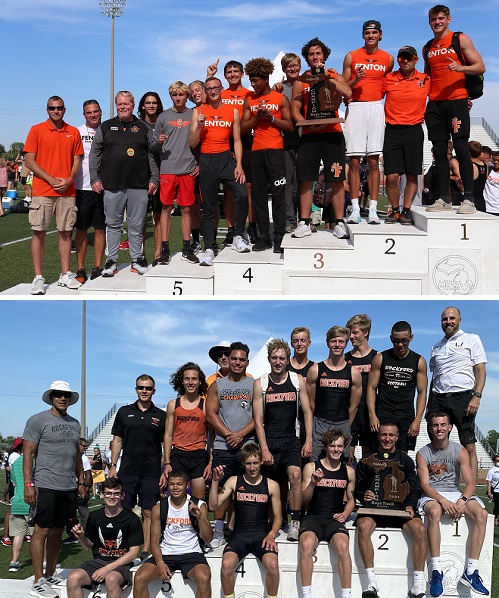 Dexter's Cole Sheldon won the pole vault (15-3) to complete an inspiring climb that included failing to qualify as a freshmen, to finishing 26th in 2019 to winning Saturday.
Dexter's Cole Sheldon won the pole vault (15-3) to complete an inspiring climb that included failing to qualify as a freshmen, to finishing 26th in 2019 to winning Saturday.
"It was just hard work," said Sheldon, who was seeded fourth. "It's nice being the underdog. I didn't have that great of a Regional, and I told my coach I was saving it for the Finals."
Sheldon also credited teammate Noah Schultz, who finished second with a vault of 14-9.
"That was probably the best thing that could have happened to me," Sheldon said. "He's the reason I did so well. If he goes high, I want to go higher."
Among other field event winners was Zachary Webb of Macomb Dakota, who won the high jump in 6-6. While some competitors are actually surprised by winning a state title, Webb doesn't count himself among them.
"I knew when I came in here I couldn't miss," he said. "I wanted to put the pressure on others, and I think I did that. I practice so much, I knew I could do this. I break down a lot of video. If I'm going bad, I look at the video and fix what I need to fix."
The other field event winners were Drake Willenborg of South Lyon in the discus (183-3), Levi Honderd of Holland in the long jump (22-6) and Ben Haas of Clarkston in the shot put (57-8).
PHOTOS: (Top) Ann Arbor Skyline’s Hobbs Kessler celebrates his victory in the 800 on Saturday. (Middle) Detroit Cass Tech’s Tamaal Myers II sets the pace during his hurdles sweep. (Below) Fenton, top, and Rockford celebrate their team championships.(Action photos by Ike Lea; team photos by John Brabbs/RunMichigan.com.)
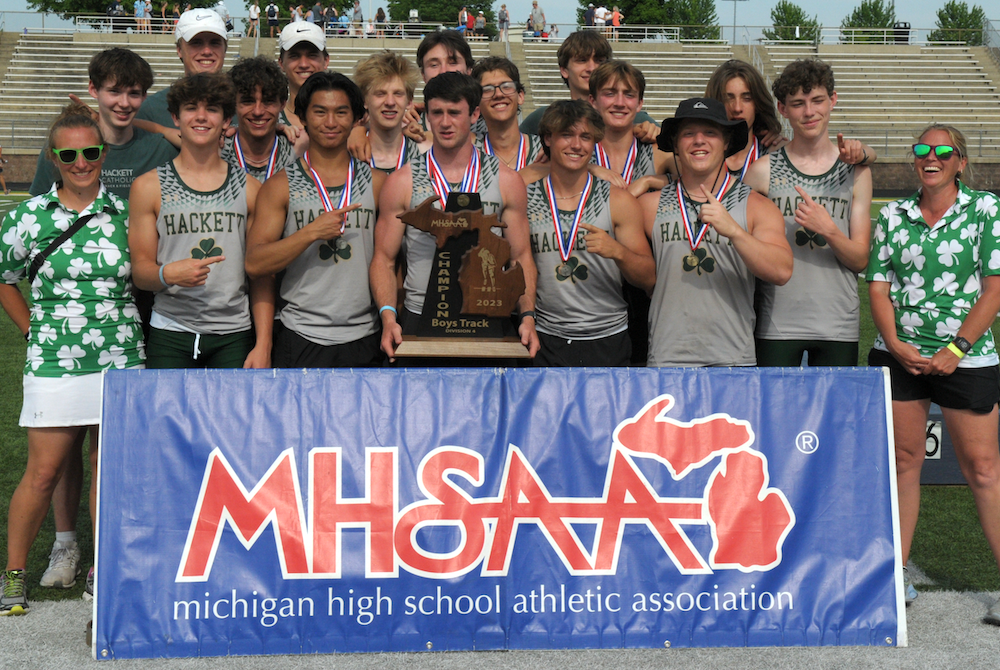
Thrower Claims Lone Individual Title to Lead Hackett to Team 3-Peat
By
Tom Lang
Special for MHSAA.com
June 3, 2023
Kalamazoo Hackett Catholic Prep just keeps winning and winning.
This time the Irish took home their fourth title in the last five Lower Peninsula Division 4 Track & Field Finals, on Saturday at Hudsonville.
Hackett’s only individual title was taken by discus winner Nathan Buchmann, a senior, who was fine knowing he was the shortest in stature among all the sizable competitors.
“In the offseason after football I worked out every day, working towards this goal,” he said after getting his medal. “I would say this takes 80 percent technique and 20 percent strength to throw the discus. So, length can help but if you have good technique and are really strong, that will play into it.
“I think we are very balanced throughout the meet today,” he said about teammates that scored points in finishes other than first place. “We have 13 guys here today, and we have people in a lot of the races. But I do not run; I have too short of legs to be a fast runner,” he said with a chuckle.
Buchmann had to work through a hip injury to compete this spring.
“I think the setbacks are what make you strong,” he said. “You can either give up through the setbacks or push forward and become better.”
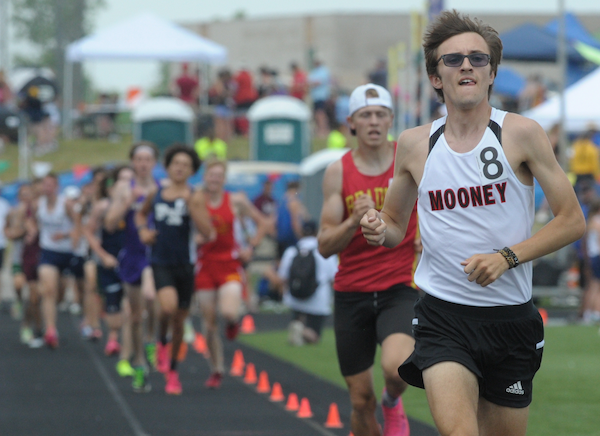 Coach Charissa Dean agreed.
Coach Charissa Dean agreed.
“The kids have big hearts,” she said after all the points were totaled and the Irish were on top once again, with 53. “They worked hard. They had a lot of potential when we started the season. And we had a lot of drive to put in the work, and we are happy the results came out the way they did.”
Reading was runner-up at 47 points, followed by Wyoming Potter’s House Christian with 42, then Fowler and Flint Beecher each with 37 points.
Senior Lezawe “Moses” Osterink, of Potter’s House Christian, placed second in 1,600 but took the 3,200 title as defending champ of both. He dominated the latter by lapping the field with a final lap kick that resembled more of a superhero speedster.
“Nobody really took it out that hard at the start,” he said. “There was a freshman (Marek Butkiewicz of Hackett) that tried to get the pace going quick, but me and Dakota (Dykhuis of Montabella) just kind of sat back and gradually pulled him through.
“We took it gradually, and I was just relying that I could kick.”
Kick did he ever. The trio were neck and neck the majority of the race in a grouping ahead of the pack.
“With 400 to go I just tried to go all out,” Osterink said. “I had a lot more left than I thought and I was pleased with the win. Not really the time, but that doesn’t matter, especially this hot out.”
The overall meet was in the low 90s/high 80s heat and searing sun all day. So, race officials allowed the unique opportunity for coaches to spray the runners with water and give them water bottles.
“It was very weird because I’ve never taken water to drink while I’m running, so I didn’t know how that would feel,” Osterink said. “And they were spraying us and hitting us in the face. It was kind of fun.”
Junior Tyler Lenn of Marine City Cardinal Mooney defeated Osterink at his own game in the 1,600.
“I’m feeling great,” Lenn said after grabbing the medal. “I said to a newspaper after one of my races (during the season) I was right where I wanted to be. This has been a long rebuilding process for me since an injury back in the fall, and I set a pretty high goal the day the injury happened. I was telling myself I needed to fulfill what I said I would do at the beginning of last cross country season. And that is what I did today.”
Lenn suffered an ankle sprain from a misstep that turned worse because he kept running through the season on it.
“Coming back from that was pretty tough, but I wouldn’t have it any other way,” he said. 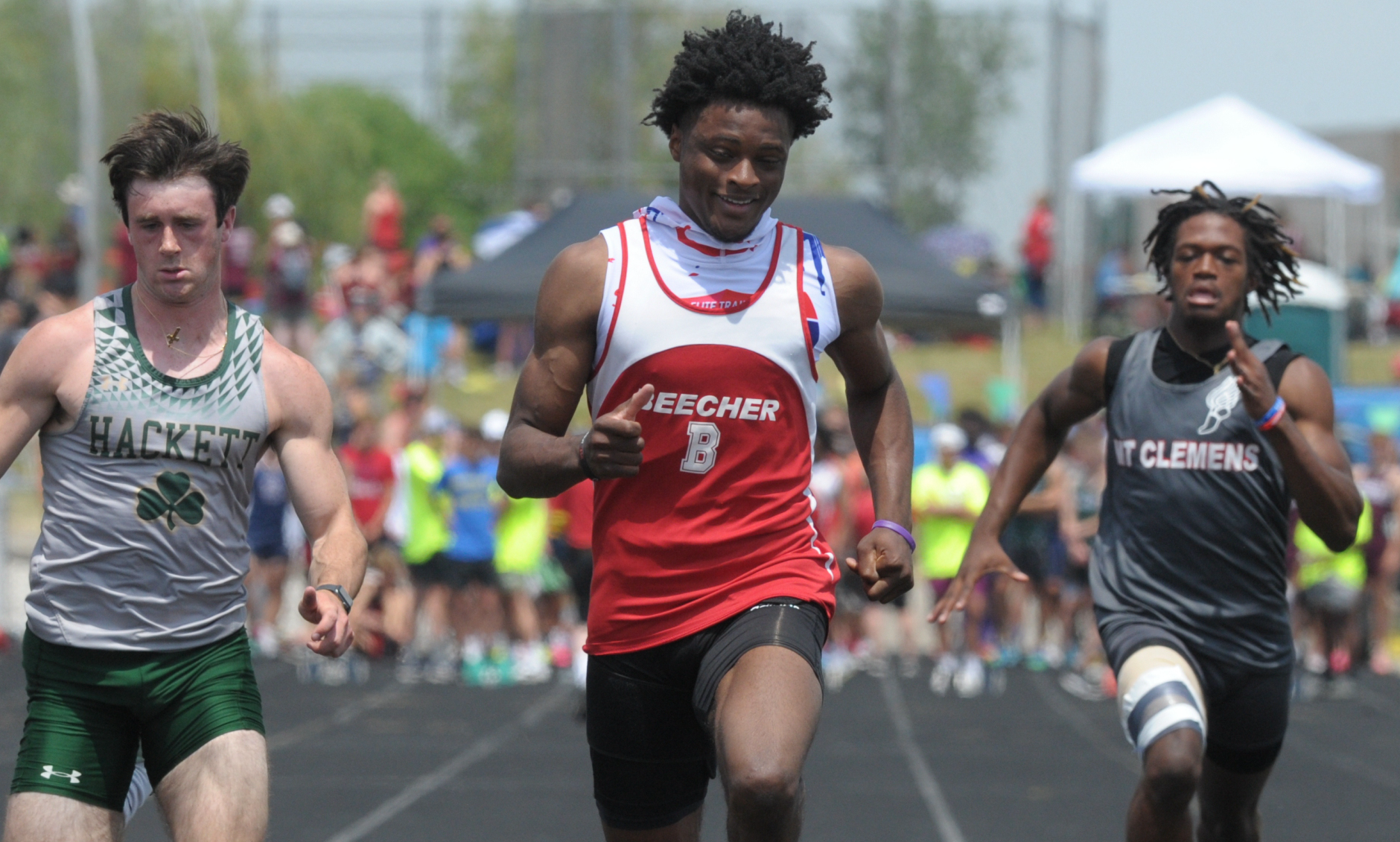 “Perseverance; I said from the beginning what I was going to do. I kept my eye on that target, and no matter the circumstances life threw at me, that I was going to make it happen and I am a man of my word.”
“Perseverance; I said from the beginning what I was going to do. I kept my eye on that target, and no matter the circumstances life threw at me, that I was going to make it happen and I am a man of my word.”
Jaylin Townsend, a senior from Flint Beecher, dominated the short races. He won the 100 dash (10.67) and 200 dash at 22 seconds flat. It was his third 100 win at a Finals.
“I put in a lot of work; I had to three-peat,” he said after the 100. “There’s a lot of great competition here, so I knew I had to come out and run my best.”
Concord in the 400 (43.72), Buckley in the 800 (1:30.76) and 1,600 (3:29.13) and Potter’s House in the 3,200 (8:14.18) were relay champs Saturday. Reading’s Tayshawn Bester won the 110 hurdles (15.13), and Athens’ Landen Bennett won the 300 (39.85). Caseville’s Nathan Feltner won the 400 (50.76), and Vestaburg’s Owen Patton claimed the 800 (1:55.11).
Fruitport Calvary Christian’s Bradley Richards won the high jump (6-10), and Peck’s Alex Affer won the long jump (23-4). McBain Northern Michigan Christian’s Isaac Bowden was first in pole vault (13-0), and Brown City’s Kyle Affer won shot put (49-2).
PHOTOS (Top) Kalamazoo Hackett Catholic Prep celebrates its third-straight LPD4 title Saturday. (Middle) Cardinal Mooney's Tyler Lenn, far right, sets the pace in the 1,600. (Below) Flint Beecher's Jaylin Townsend, middle, crosses the finish first for one of his two sprint championships. (Photos by Ken Swart/RunMichigan.com.)

